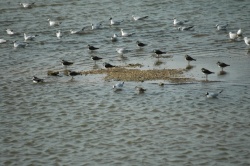Overview
North Cave Wetlands comprises of a series of lakes built on the site of a form Sand Quarry to the West of North Cave.
As well as the 6 large lakes, there are a number of smaller dragonfly ponds and scrapes around the reserve and a dyke runs along its Northern edge. A strip of land in the northeastern corner of the reserve is planted with cover crops and is known as the Maize Field. The reserves borders are planted with trees and bushes, largely alder and hawthorn.
Birds
Notable Species
Pied Avocet and Little Ringed Plover have bred on the reserve and Common Sandpiper and Green Sandpiper are regularly seen in the summer.
All common duck species can be seen, and in winter Goldeneye, Smew and Goosander are possible.
Raptors seen include Red Kite, Common Buzzard, Common Kestrel, Eurasian Sparrowhawk, Peregrine, Hobby in summer, and on some occasions Marsh Harrier.
Passerines are well represented on the reserve, in winter Corn Bunting, Bullfinch, Lesser Redpoll and Siskin can be found, along with large numbers of Goldfinch, Greenfinch and Tree Sparrow. In the Summer, Reed Warbler, Sedge Warbler,Lesser Whitethroat and Common Whitethroat all breed on the reserve.
Island Lake is home to a large breeding colony of Black-headed Gull, and the steep sandy cliff on this lake is home to Sand Martin. Common Kingfisher and Green Woodpecker are regularly seen.
Rarities
Ring-necked Duck, Temminck's Stint, Pectoral Sandpiper, Green-winged Teal, Grey Phalarope, Mealy Redpoll.
Check-list
Birds you can see here include:
Little Grebe, Great Crested Grebe, Black-necked Grebe, Mute Swan, Whooper Swan, Greylag Goose, Pink-footed Goose, Canada Goose, Common Shelduck, Eurasian Wigeon, Gadwall, Common Teal, Mallard, Northern Pintail, Garganey, Northern Shoveler, Common Pochard, Tufted Duck, Common Goldeneye, Smew, Goosander, Scaup, Eurasian Sparrowhawk, Osprey, Common Kestrel, Merlin, Peregrine Falcon, Hobby, Red Kite, Common Buzzard, Red-legged Partridge, Grey Partridge, Quail, Water Rail, Common Moorhen, Common Coot, Little Ringed Plover, Ringed Plover, Eurasian Golden Plover, Northern Lapwing, Little Stint, Temminck's Stint, Curlew Sandpiper, Dunlin, Ruff, Common Snipe, Jack Snipe, Eurasian Curlew, Common Redshank, Common Greenshank, Green Sandpiper, Wood Sandpiper, Common Sandpiper, Black-tailed Godwit, Eurasian Oystercatcher, Pied Avocet, Little Gull, Mediterranean Gull, Black-headed Gull, Common Gull, Lesser Black-backed Gull, European Herring Gull, Great Black-backed Gull, Common Tern, Little Owl, Short-eared Owl, Tawny Owl, Western Barn Owl, Common Swift, Common Kingfisher, Sand Martin, Barn Swallow, Western House Martin, Eurasian Skylark, Meadow Pipit, Grey Wagtail, Yellow Wagtail, Pied Wagtail, Stock Dove, Common Wood Pigeon, Eurasian Collared Dove, Common Wren, Dunnock, European Robin, European Stonechat, Eurasian Blackbird, Fieldfare, Song Thrush, Redwing, Mistle Thrush, Sedge Warbler, Common Reed Warbler, Common Grasshopper Warbler, Garden Warbler, Blackcap, Willow Warbler, Common Whitethroat, Lesser Whitethroat, Eurasian Magpie, Carrion Crow, Chaffinch, European Greenfinch, Eurasian Siskin, Lesser Redpoll, Northern Redpoll, Reed Bunting, Corn Bunting, Yellowhammer
Site Information
History and Use
The reserve is built on a former Sand Quarry acquired by the Yorkshire Wildlife trust in 2000. The Yorkshire Wildlife trust are currently implementing plans to extend the reserve to the South and West, which will more than double its total area.
Areas of Interest
The main lake is viewed from South Hide, accessible from Dryham lane. This lake is the deepest and most exposed of the lakes, and winter holds the majority of ducks. In summer Black-necked Grebe can occasionally be seen. A floating raft offers a perch for cormorants, and Common Tern breed here.
Village Lake can be viewed from both the Turret Hide and East Hide. At East Hide a board with notes of the latest sightings can be found. These hides also look across to the centre of the reserve onto an area of grass meadow, which is cut every year in the late summer. The Turret Hide also overlooks Island lake. Island lake's and Village's Lakes water levels are raised and lowered on an annual basis to provide areas of bare mud on which waders can feed.
The Maize Field is sown with cereals for the benefit of Pheasants and Partridges, and to provide food for finches and buntings. In the corner of the maize field a bird feeder has been erected, which is visited by Tree Sparrow, Reed Bunting, Bullfinch, and Great Spotted Woodpecker among others.
The entire perimeter of the reserve is accessible, and the perimeter path offers views of the Reedbed lake, Far Lake, and Carp Lake.
Access and Facilities
The reserve is accessed from Cliffe Road and parking is available on Dryham lane, as is an area to lock bikes. Toilet facilities are provided, and food is available most of the time. Two of the three hides are wheelchair accessible, and around a third of the paths are gravelled.
Directions from M62: leave at Junction 38, and travel towards the village of North Cave (signposted) on the B1230. Turn left onto Cliffe Road just before reaching the village itself. Follow this road round (turning left at what appears to be a crossroads) and the Dryham lane entrance is clearly marked on the next corner.
Grid reference: SE886328





